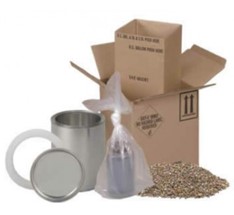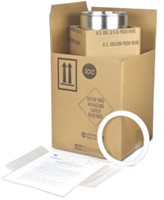Online Hazmat Training- Intermediate Packaging and Hydrostatic Pressure Requirements
Can a paint can be used to meet the hydrostatic pressure requirements for shipping by air? Successful completion of online hazmat training will often answer the question, but nonetheless, it’s not uncommon to run into quandaries of this sort in the field, even as a trained and experienced hazmat employee.
It happens all the time; the Shipping Department is asked to send a plastic bottle of a liquid hazardous material, overnight service to arrive the next day to a domestic destination in the U.S. The bottle is not normally used to ship liquid hazardous materials and the shipper is not certain it is capable of meeting the general requirements for shipping by air. However, the shipper has in his possession UN Non-Bulk Performance-Oriented Packaging with paint can inner packaging that are capable of meeting these requirements. The shipper decides to put the plastic bottle inside the paint can with some cushioning material to serve the purpose of absorbent and cushioning material and ships it. Is this a legal option, can it be done?
Online Hazmat Training – Pressure requirements
Hazardous materials shipped by air are subjected to many forces including extreme changes to pressure and temperature. These changes in the environment and the effects they have on the material being shipped can cause the package to fail during transportation if not thoroughly tested and approved. For these reasons, packages shipped by air have more stringent performance requirements placed on them.
49 CFR §173.27 outlines the requirements for packaging used for air transport. One of these requirements relates to pressure differential. Packaging must be capable to withstand certain pressure differentials without leakage to be used for air transport.
Online Hazmat Training – Can a paint can be used as an intermediate packaging to meet pressure requirements?
All UN packaging must be designed and tested as it is intended to be used in transportation. Once a design type has successfully completed testing, a complete test report and closure instructions are created. Closure instructions are required to be provided when the packaging is purchased. Test reports can be requested from the manufacturer.
The closure instructions and test report communicate to the user everything they need to determine if a packaging can be used to ship their hazmat. These documents must include detailed information about the physical characteristics of the packaging, including measurements and components used for testing. They also include instructions to ensure the packaging is closed in the same manner it was tested.
Many paint can combination packagings used to ship paint or other similar liquid hazardous materials such as adhesives are tested to carry free liquid inside the can. The paint cans in the outer packaging are considered inner packaging. If a bottle of liquid hazmat is placed inside the paint can, the bottle becomes the inner packaging and the paint can becomes an intermediate packaging. The new configuration is no longer the same as what was originally tested and the packaging meets the definition of different packaging. The new configuration would have to undergo testing to be used for transportation.
There are many packagings on the hazmat supplies market that have been tested with a paint can as an intermediate packaging. It is important to talk with the vendor to determine if the packaging is suitable to be used as desired. The answer to the initial questions is “no”. Although the paint can combination packaging met the inner and outer testing requirements, the plastic bottle was not part of the UN Specification Testing Standards therefore the shipper must either purchase a plastic bottle that has successfully passed the shipping by air standards, or locate a combination packaging that allows for the paint can to be the intermediate packaging and the plastic bottle to be the inner packaging.
To follow are some great examples of packages that have been tested and determined to be suitable to transport inner packaging that have not been tested for air transport.


Online Hazmat Training Programs by Hazmat University
Hazmat University offers comprehensive online hazmat training for hazmat employees, freight forwarders, shippers, and supply chain who perform functions that are governed by the hazardous material regulations.
The online hazmat training is self-paced and may be completed even from the comfort of your own home, which is even more essential during these times of social distancing. To find out more about our hazmat training programs, call us today at (844) 801-2765 or (609) 493-4972.